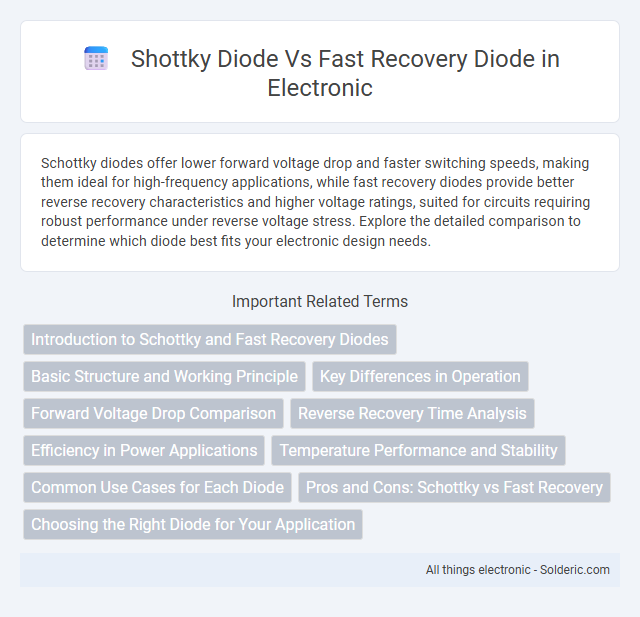Schottky diodes offer lower forward voltage drop and faster switching speeds, making them ideal for high-frequency applications, while fast recovery diodes provide better reverse recovery characteristics and higher voltage ratings, suited for circuits requiring robust performance under reverse voltage stress. Explore the detailed comparison to determine which diode best fits your electronic design needs.
Comparison Table
| Feature | Schottky Diode | Fast Recovery Diode |
|---|---|---|
| Recovery Time | Very fast (nanoseconds) | Fast (tens to hundreds of nanoseconds) |
| Forward Voltage Drop | Low (0.2-0.3 V) | Higher (0.7-1.1 V) |
| Reverse Leakage Current | Higher leakage current | Lower leakage current |
| Maximum Voltage Rating | Typically up to 100 V | Up to several hundred volts |
| Applications | Power supplies, RF circuits, voltage clamping | Switching power supplies, inverters, motor drives |
| Material | Metal-Semiconductor Junction | PN Junction |
Introduction to Schottky and Fast Recovery Diodes
Schottky diodes feature a low forward voltage drop and rapid switching capabilities, making them ideal for high-frequency applications and power efficiency. Fast recovery diodes possess a short reverse recovery time, reducing switching losses in circuits like inverters and switch-mode power supplies. Your choice between these diodes depends on the required switching speed and power efficiency for your electronic design.
Basic Structure and Working Principle
Schottky diodes feature a metal-semiconductor junction, enabling rapid switching by minimizing charge storage and providing low forward voltage drop, which enhances efficiency in high-frequency applications. Fast recovery diodes consist of a p-n junction with optimized charge carrier recombination techniques to reduce reverse recovery time, improving performance in circuits with moderate switching speeds. Understanding these differences helps you select the ideal diode for applications requiring fast switching and low power loss.
Key Differences in Operation
Schottky diodes feature a metal-semiconductor junction, resulting in a low forward voltage drop and ultra-fast switching speed, which minimizes power loss and improves efficiency in high-frequency applications. Fast recovery diodes possess a pn-junction with a designed short reverse recovery time, enabling quicker transitions from conducting to blocking states while handling higher voltage and current stresses. Your choice depends on whether you prioritize low forward voltage and switching speed (Schottky) or high voltage tolerance with fast recovery characteristics (fast recovery diode).
Forward Voltage Drop Comparison
Schottky diodes exhibit a lower forward voltage drop, typically between 0.2 to 0.4 volts, compared to fast recovery diodes which range from 0.7 to 1.1 volts. This lower forward voltage drop results in higher efficiency and reduced power dissipation in high-frequency applications. As a result, Schottky diodes are preferred in circuits requiring minimal voltage loss and faster switching speeds.
Reverse Recovery Time Analysis
Schottky diodes feature significantly lower reverse recovery times compared to fast recovery diodes, often in the nanosecond range, which reduces switching losses and improves efficiency in high-frequency applications. Fast recovery diodes, while faster than standard silicon diodes, still exhibit longer reverse recovery times due to minority carrier charge storage, leading to increased power dissipation during turn-off. Your choice between these diodes should consider the impact of reverse recovery time on circuit performance, especially in power electronics and switching power supplies.
Efficiency in Power Applications
Schottky diodes exhibit higher efficiency in power applications due to their low forward voltage drop, typically between 0.15 to 0.45 volts, which minimizes conduction losses. Fast recovery diodes, while capable of handling high voltage and current, have higher forward voltage drops, around 0.7 volts, leading to increased power dissipation and reduced efficiency. The rapid switching performance of Schottky diodes further enhances efficiency in high-frequency power circuits by reducing switching losses compared to fast recovery diodes.
Temperature Performance and Stability
Schottky diodes exhibit superior temperature performance due to their low forward voltage drop and minimal junction capacitance, allowing for efficient operation at higher temperatures with reduced thermal runaway risk. Fast recovery diodes provide better stability under transient conditions, maintaining consistent reverse recovery times and lower reverse recovery charge, which enhances performance in switching applications. Your choice depends on whether optimized high-temperature operation or reliable switching stability is paramount.
Common Use Cases for Each Diode
Schottky diodes are commonly used in high-frequency applications such as power rectifiers in switching power supplies and RF circuits due to their low forward voltage drop and fast switching speed. Fast recovery diodes are preferred in applications requiring efficient reverse recovery performance, like motor drives, inverters, and power factor correction circuits, where minimizing switching losses is critical. Your choice depends on whether priority is low forward voltage for efficiency or rapid recovery time to handle switching transients effectively.
Pros and Cons: Schottky vs Fast Recovery
Schottky diodes offer low forward voltage drop, resulting in higher efficiency and faster switching speed, making them ideal for high-frequency applications, but they have lower reverse voltage ratings and higher leakage current compared to fast recovery diodes. Fast recovery diodes can handle higher voltage and current surges with lower reverse leakage, but their slower switching speed causes increased switching losses and reduced efficiency in high-speed circuits. Your choice between these two depends on voltage requirements, efficiency needs, and the switching frequency of your application.
Choosing the Right Diode for Your Application
Shottky diodes offer low forward voltage drop and extremely fast switching speeds, making them ideal for low-voltage, high-frequency applications such as power supplies and RF circuits. Fast recovery diodes excel in handling higher voltage and current with moderate switching speeds, suitable for rectification and inductive load switching in power electronics. Selecting the right diode depends on factors like voltage rating, switching speed, efficiency requirements, and thermal performance specific to your circuit's needs.
shottky diode vs fast recovery diode Infographic

 solderic.com
solderic.com